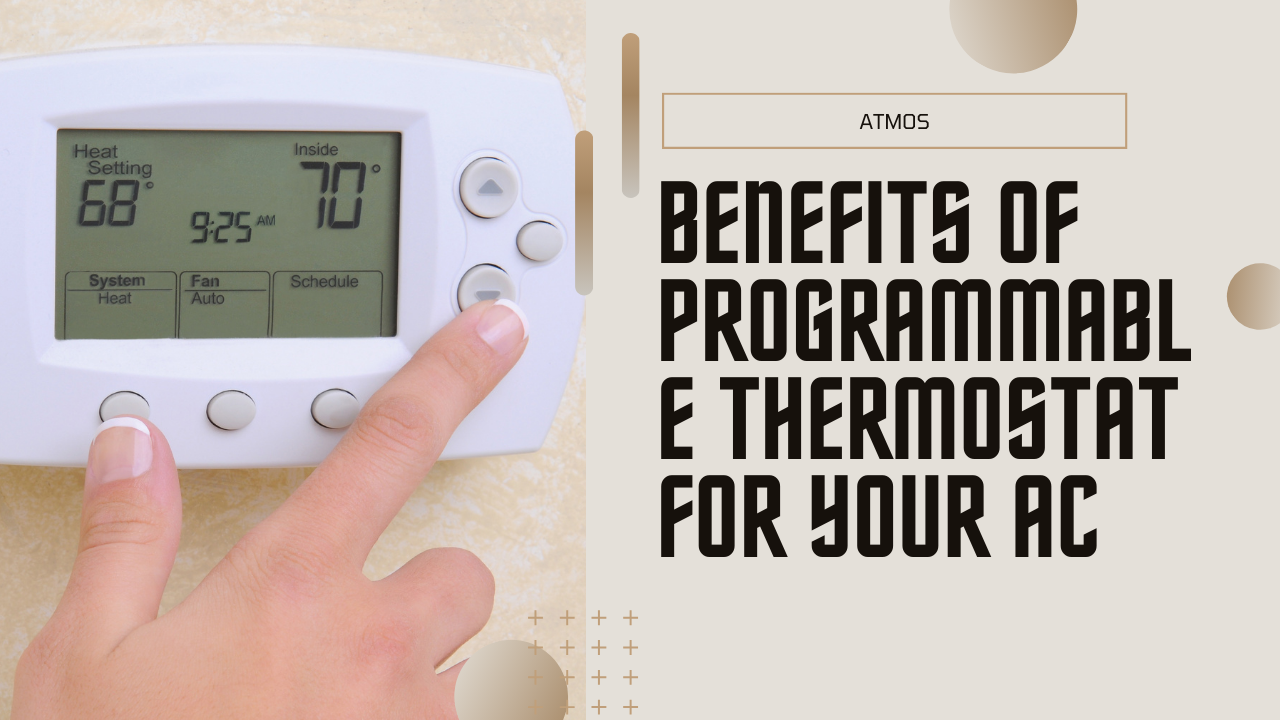In the quest for enhanced home comfort and energy efficiency, programmable thermostats have emerged as a pivotal technology. These devices, which can be programmed to adjust the temperature based on a set schedule, offer a host of benefits over traditional thermostats. As climate control systems become increasingly sophisticated, understanding the advantages of programmable thermostats can help homeowners make informed decisions about their HVAC systems.
This article explores the various benefits of using a programmable thermostat with your air conditioning (AC) system, shedding light on how these devices contribute to energy savings, cost reduction, and improved comfort.
Understanding Programmable Thermostats
Definition and Types of Programmable Thermostats
A programmable thermostat is a device that allows users to set temperature schedules for different times of the day and week. Unlike manual thermostats, which require constant adjustments, programmable thermostats automate temperature changes based on pre-set programs. There are several types of programmable thermostats, each designed to cater to different needs and preferences.
- 7-Day Programmable Thermostats: These models offer the most flexibility, allowing users to create a unique schedule for each day of the week. This is ideal for households with varying schedules or those who prefer to have different temperature settings for weekends versus weekdays.
- 5-2 Day Programmable Thermostats: This type allows for a different schedule during the week and a uniform setting for weekends. It’s a good choice for people who have a consistent workweek schedule but want to adjust the temperature differently on weekends.
- Smart Thermostats: These advanced models go beyond basic programming by integrating with smart home systems. They offer features such as remote access via mobile apps, adaptive learning to optimize temperature settings, and integration with voice assistants like Amazon Alexa or Google Assistant.
Key Features and Functionalities
Programmable thermostats come equipped with various features designed to enhance their functionality. Key features include:
- Scheduling Options: Programmable thermostats allow users to set specific heating and cooling schedules for different times of the day and week. This can include setting different temperatures for when the household is occupied versus when it is empty.
- Remote Access: Many modern programmable thermostats offer remote control through mobile apps. This allows users to adjust settings from anywhere, ensuring that the home is at the desired temperature upon arrival.
- Adaptive Learning: Smart thermostats with adaptive learning capabilities can analyze user behavior and adjust settings automatically to optimize comfort and efficiency.
Energy Efficiency and Cost Savings
How Programmable Thermostats Contribute to Energy Savings
One of the most significant advantages of programmable thermostats is their ability to enhance energy efficiency. By automating temperature adjustments, these devices help reduce unnecessary heating and cooling, which directly translates to energy savings.
Programmable thermostats can be set to lower the temperature when the home is unoccupied or during the night when lower temperatures are comfortable. This reduces the workload on the HVAC system, preventing it from running continuously and wasting energy.
Impact on Utility Bills
The energy savings achieved with programmable thermostats can lead to substantial reductions in utility bills. According to the U.S. Department of Energy, homeowners can save up to 10% on heating and cooling costs by using a programmable thermostat to adjust temperatures when they are asleep or away from home. This savings can accumulate over time, providing a return on investment that offsets the initial cost of the thermostat.
Comparison with Traditional Thermostats
When compared to traditional thermostats, programmable models offer a clear advantage in terms of energy efficiency and cost savings. Traditional thermostats require manual adjustments, which often leads to inconsistent temperature settings and increased energy consumption. In contrast, programmable thermostats maintain a consistent schedule, ensuring that the HVAC system operates efficiently.
Several case studies and statistics highlight the financial benefits of programmable thermostats. For example, a study by the American Council for an Energy-Efficient Economy (ACEEE) found that homes with programmable thermostats experienced an average reduction in energy usage of 15%. This translates to significant savings on annual utility bills, making programmable thermostats a worthwhile investment for homeowners seeking to improve their energy efficiency.
Enhanced Comfort and Convenience
Customizable Temperature Settings
Programmable thermostats offer unparalleled customization when it comes to temperature settings. Users can create schedules that align with their daily routines, ensuring that the home is always at a comfortable temperature when they are present. For instance, a homeowner can set the thermostat to lower the temperature before they arrive home from work, ensuring a cool and comfortable environment upon their return.
Remote Control and Management
Modern programmable thermostats come equipped with remote control capabilities. Mobile apps provide users with the convenience of adjusting temperature settings from anywhere, whether they are at work, on vacation, or simply in a different room. This feature is particularly useful for making last-minute adjustments or for managing temperature settings while away from home.
Voice control integration is another feature that enhances convenience. Many smart thermostats can be controlled through voice commands using smart home systems like Amazon Alexa or Google Assistant. This allows users to make adjustments hands-free, adding an extra layer of ease to temperature management.
Improved Temperature Consistency and Comfort
Programmable thermostats help maintain a consistent temperature throughout the home. By following a set schedule, these devices ensure that the temperature remains steady, avoiding the fluctuations that can occur with manual adjustments. This consistency contributes to a more comfortable living environment and helps prevent the discomfort associated with sudden temperature changes.
Environmental Benefits
Reduction in Energy Consumption
The environmental impact of programmable thermostats extends beyond energy savings. By reducing energy consumption, these devices contribute to a decrease in overall energy demand. This reduction helps lower the strain on power grids and reduces the need for additional energy production, which can be associated with increased greenhouse gas emissions.
Lower Carbon Footprint
Using a programmable thermostat helps lower a home’s carbon footprint. By optimizing HVAC operation and reducing energy consumption, homeowners contribute to a reduction in carbon emissions. This aligns with broader environmental goals of reducing greenhouse gas emissions and promoting sustainable living practices.
Contribution to Sustainable Living
Programmable thermostats play a role in promoting sustainable living. By making it easier for homeowners to manage their energy usage, these devices support efforts to reduce environmental impact. Additionally, many programmable thermostats are designed with energy-efficient components and are often produced with environmentally friendly manufacturing processes.
Installation and Maintenance
Ease of Installation
The installation of a programmable thermostat is generally straightforward. Many models are designed for easy DIY installation, with detailed instructions provided by the manufacturer. For those who are not comfortable with DIY projects, professional installation is also an option.
Compatibility with existing HVAC systems is an important consideration. Most programmable thermostats are compatible with a wide range of heating and cooling systems, including central air conditioners, heat pumps, and furnaces. However, it is advisable to check compatibility before purchasing a thermostat to ensure a seamless installation process.
Routine Maintenance and Updates
Maintaining a programmable thermostat involves routine checks and updates. For smart thermostats, software updates may be required to ensure optimal performance and access to the latest features. Additionally, regular checks of batteries and sensors are important to ensure accurate temperature readings and reliable operation.
Potential Drawbacks and Considerations
Initial Cost and Investment
One potential drawback of programmable thermostats is the initial cost. While prices have decreased over time, advanced models, especially smart thermostats, can still be relatively expensive. However, the long-term savings on energy bills often outweigh the initial investment.
Learning Curve and Setup Complexity
Some users may find the setup and programming of programmable thermostats to be challenging, especially with advanced models that offer extensive customization options. It may take time to become familiar with the features and programming options. However, many manufacturers provide user-friendly interfaces and customer support to assist with the setup process.
Limitations in Certain Scenarios
Programmable thermostats may have limitations in certain scenarios, such as with older HVAC systems that lack compatibility with advanced features. Additionally, households with highly variable schedules may need to invest time in configuring schedules to maximize the benefits of a programmable thermostat.
Choosing the Right Programmable Thermostat
Factors to Consider
When selecting a programmable thermostat, several factors should be considered. Home size and the type of HVAC system are important considerations, as different thermostats offer varying levels of compatibility and functionality. Budget and desired features also play a role in the decision-making process.
Recommendations and Top Brands
There are several reputable brands that offer high-quality programmable thermostats. Brands such as Nest, Ecobee, Honeywell, and Emerson provide a range of options, from basic programmable models to advanced smart thermostats with extensive features. Consumer reviews and ratings can provide additional insights into the performance and reliability of different models.
Embrace Comfort and Efficiency – The Long-Term Gains of Programmable Thermostats

In conclusion, programmable thermostats offer a multitude of benefits that enhance both home comfort and energy efficiency. By automating temperature adjustments, these devices contribute to significant energy savings, reduced utility bills, and improved temperature consistency. Additionally, programmable thermostats support environmental sustainability by lowering energy consumption and reducing carbon emissions.
While there are considerations such as initial cost and setup complexity, the long-term advantages of programmable thermostats make them a valuable addition to any home. For homeowners seeking to optimize their HVAC system and improve their living environment, investing in a programmable thermostat is a decision that promises substantial rewards in comfort, efficiency, and sustainability.




